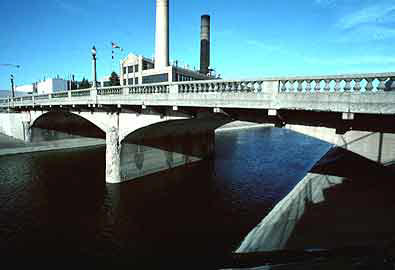We Recommend:
Bach Steel - Experts at historic truss bridge restoration.
BridgeHunter.com Phase 1 is released to the public! - Visit Now
Chevrolet Bridge

Primary Photographer(s): Nathan Holth
Bridge Documented: August 14, 2003 and April 17, 2006
Flint: Genesee County, Michigan: United States
1917 By Builder/Contractor: Illinois Bridge Company of Chicago, Illinois
Not Available or Not Applicable
75.0 Feet (22.9 Meters)
143.0 Feet (43.6 Meters)
36 Feet (10.97 Meters)
3 Main Span(s)
254238800208B01

View Information About HSR Ratings
Bridge Documentation
This bridge no longer exists!
View Archived National Bridge Inventory Report - Has Additional Details and Evaluation
This historic bridge was demolished Summer 2006.
This bridge lived in what looked like a concrete world when it was demolished in 2006. This bridge used to be surrounded by factories, many or all related to the auto industry. Some of these factories were standing as late as 2003. All that remains in this area is acres upon acres of concrete. Even the river was filled with concrete, in a project that MDOT mentions narrowed the crossing, turning this three span bridge into the two span bridge seen today. Today one might not imagine a more barren scene, until they realize that now, the last item of note in the area, the bridge itself, was demolished and replaced with a slab of concrete.
The demolition of this bridge was a foolish decision on the part of Flint. The unused concrete-paved land around the bridge could have been ripped up, and a park could have been created. Then, the historic bridge could be restored for vehicular traffic, or bypassed by a new vehicular bridge, with the historic bridge restored for use of pedestrians in the park. Such a solution would preserve valuable history and help create a new use for the abandoned land in the area.
This bridge was extremely rare as an example of a bridge built under a Luten patent.
Note that the bridge MDOT mentions in Calhoun County has been demolished as well.
Information and Findings From Michigan Historic Bridge InventoryNarrative Description
Located just north of M-56, this
concrete bridge carries Chevrolet Avenue over the Flint River. Known locally as the Chevrolet Bridge, the structure is situated next to the old Fisher Body Plant of Chevrolet and was the scene of a sit-down strike at the plant in
the 1930s. Statement of Significance Since that time the Chevrolet Bridge has carried heavy traffic on this important inner-city artery, with its rehabilitation in the 1960s as the only alteration of note. The bridge's Luten configuration, though typical of Flint bridges, was uncommon among highway bridges in Michigan. The Twelve-Mile Road Bridge in Calhoun County, identified by Charles Hyde as being built by the Illinois Bridge Company in 1907, may be the oldest Luten-design bridge in the state. The South Cass Street Bridge in Traverse City also uses a Luten configuration. No other Luthen arches outside of Flint have been identified by Michigan's bridge inventories. The Chevrolet Bridge is distinguished as the oldest of the city's six remaining Luten arch bridges. Although altered, it is a significant Michigan example of this important, though now rare, patented bridge type. |
This bridge is tagged with the following special condition(s): Luten and Unorganized Photos
![]()
Photo Galleries and Videos: Chevrolet Bridge
Bridge Photo-Documentation
A collection of overview and detail photos. This photo gallery contains a combination of Original Size photos and Mobile Optimized photos in a touch-friendly popup viewer.Alternatively, Browse Without Using Viewer
![]()
Additional Unorganized Photos
Original / Full Size PhotosThis photo gallery features older ca. 2003-2006 photos taken when the website only included a few photos in original size on the website, and a smaller quantity of reduced size photos as well. This unorganized gallery may partially duplicate photos in other galleries on this bridge's page, however all photos here are available in the Original / Full Size. This gallery offers photos in the highest available resolution and file size in a touch-friendly popup viewer.
Alternatively, Browse Without Using Viewer
![]()
Additional Unorganized Photos
Mobile Optimized PhotosThis photo gallery features older ca. 2003-2006 photos taken when the website only included a few photos in original size on the website, and a smaller quantity of reduced size photos as well. This unorganized gallery may partially duplicate photos in other galleries on this bridge's page, however all photos here are available in the Original / Full Size. This gallery features data-friendly, fast-loading photos in a touch-friendly popup viewer.
Alternatively, Browse Without Using Viewer
![]()
Maps and Links: Chevrolet Bridge
This historic bridge has been demolished. This map is shown for reference purposes only.
Coordinates (Latitude, Longitude):
Search For Additional Bridge Listings:
Bridgehunter.com: View listed bridges within 0.5 miles (0.8 kilometers) of this bridge.
Bridgehunter.com: View listed bridges within 10 miles (16 kilometers) of this bridge.
Additional Maps:
Google Streetview (If Available)
GeoHack (Additional Links and Coordinates)
Apple Maps (Via DuckDuckGo Search)
Apple Maps (Apple devices only)
Android: Open Location In Your Map or GPS App
Flickr Gallery (Find Nearby Photos)
Wikimedia Commons (Find Nearby Photos)
Directions Via Sygic For Android
Directions Via Sygic For iOS and Android Dolphin Browser
USGS National Map (United States Only)
Historical USGS Topo Maps (United States Only)
Historic Aerials (United States Only)
CalTopo Maps (United States Only)


